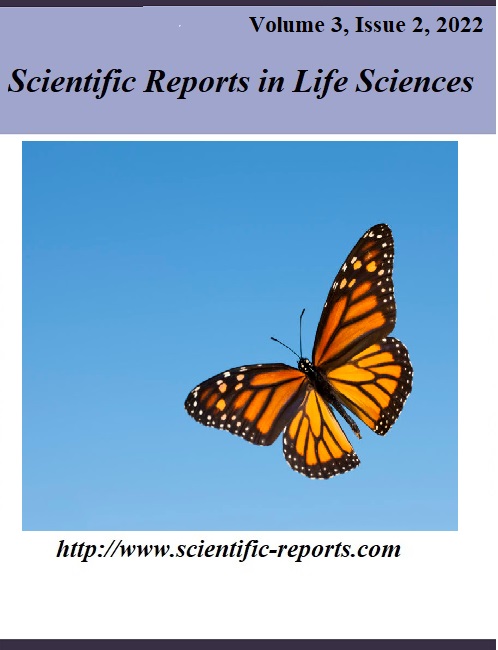Diversity Of Epiphytic ferns in the cross river national park, Akamkpa, Nigeria as indicators of forest disturbance
DOI:
https://doi.org/10.5281/zenodo.6841074Keywords:
Akamkpa, Cross river national park, diversity, epiphytic ferns, forest disturbance, NigeriaAbstract
Epiphytic ferns are autotrophic plants that are essential and delicate members of humid forests, such that their diversity can be adversely affected by any form of disturbances in the forests. Generally, their diversity is greater in the primary forest than in disturbed habitats. Thus, the diversity of epiphytic ferns at the core and buffer zone of the Cross River National Park (CRNP), Akamkpa, Nigeria was investigated. In each study site, 10 (20 × 20m) plots were marked out and sampled taking into account (trees with epiphytic ferns, canopy type, bark texture, girth at breast height (GBH), and the presence or absence of grooves on trees). The statistical analysis showed a positive correlation (r = 0.67 and 0.68) in the epiphyte diversity between the core and buffer zone. Six species of epiphytic ferns (Asplenium nudas, Phloebodium aureum, Platycerium coronarium, Drynaria laurentii, Nephrolepsis biserrata and Cyathea cooperi) were recorded in both study sites. Trees with rough bark texture had a higher number of epiphytic ferns than those with smooth bark. The ferns were mostly attached to the trunk (35) followed by the joint between the branch and trunk (15) and the primary branch (6). The low diversity of epiphytic ferns in the core zone of the CRNP is an indicator of forest disturbance.
References
Adeyemi A.A., Ibe A.E., Okedimma F.C. 2015. Tree structural and species diversitiesin Okwango forest, Cross River State, Nigeria. Journal of Research in Forestry Wildlife and Environment, 7, 36-53. Available at: www.ajol.info/index.php/jrfwe/issue /view/12999 Accessed 20 November, 2018
Aigbe H.I., Omokhua G.E. 2015. Tree species composition and diversity in Oban forest reserve, Nigeria. Journal of Agricultural Studies, 3 (1), 10-24. DOI:10.1111/j.1095-8339.1992.tb00240.x.
Aju P. C., Ezeibekwe I. O. 2010. Understanding and appreciating the need for biodiversity conservation in Nigeria. Journal of Medicinal Plants Research, 42, 2605-2608. DOI: 10.5897/JMPR09.100
Alpert P. 2000. The discovery, scope, and puzzle of desiccation tolerance in plants. Plant Ecology, 151, 5–17. Available at: www.esalq.usp.br//epse/ings/contendo_thumb Accessed 23 February, 2016
Andama E., Charles M.M., Gebhard B.L. 2003. Studies on epiphytic ferns as potential indicators of forest disturbances. Proceedings of XII World Forestry Congress. Available at: www.fao.org/documemt/ARTICLE/wke/XII/0129-BI.HTML Accessed 13 December, 2015
Barkman J.J. 1995. Phytosociology and ecology of cryptogamic epiphytes. Van Gorcucm and Company, Assen Press. Pp.624.
Barlow J., Gardner T.A., Araujo I.S., Ávila-Pires T.C., Bonaldo A.B. 2007. Quantifying the biodiversity value of tropical primary, secondary, and plantation forests. Proceedings of the National Academy of Science, 104, 18555–18560. DOI: 10.1073/pngs.0703333104
Barthlott W., Schmitt-Neuerburg V., Nieder J., Engwald S. 2001. Diversity and abundance of vascular epiphytes: a comparison of secondary vegetation and primary montage rain forest in the Venezuelan Andes. Plant Ecology, 152, 145–156. DOI: 10.1023/A:1011483901452
Bellard C., Bertelsmeier C., Leadley P., Thuiller W., Courchamp, F. 2012. Impacts of climate change on the future of biodiversity. Ecology Letters, 15, 365-377. DOI: 10.1111/j.1461-0248.2011.01736.x.
Benzing D.H. 1981. Bark surface and the origin and maintenance of diversity among angiosperm epiphytes: A hypothesis. Selbyana, 5, 248-255. www.jstor.org/stable/41759641
Benzing D.H. 1990. Vascular epiphytes: general biology and related biota. Cambridge University Press, Cambridge. Pp.23. ISBN 9780521266307
Buckling A., Kassen R., Bell G., Rainey P.B. 2000. Disturbance and diversity in experimental microcosms. Nature, 408, 961-964. DOI: 10.1038/35050080 PMID: 11140680
Callaway R.M., Reinhart K.O., Moore G.W. 2002. Epiphyte host preferences and host traits: mechanisms for species specific interactions. Oecologia, 132, 221–230. DOI: 10.1007/S00442-002-0943-3.Epub2002 Jul 1.
Cardelus C.L, Colwell R.K., Watkins J.E. 2006. Vascular epiphyte distribution patterns: explaining the mid-elevation richness peak. Journal of Ecology, 94, 144 -156. DOI: 10.1111/j.1365-2745.2005.01052.x.
Chomba C., Senzota R., Chabwela H., Nyirenda V. 2011. The influence of host tree morphology and stem size on epiphyte biomass distribution in Lusenga Plains National Park, Zambia. Journal of Ecology and the Natural Environment, 3, 370-380. Available at: www.academicjournals.org/JENE Accessed 6 October, 2017
Cook W.M., Lane K.T., Foster B.L., Holt R.D. 2002. Island theory, matrix effects and species richness patterns in habitat fragments. Ecology Letters, 5(5), 619-623. DOI: 10.1046/j.1461-0248.2002.00366.x
Erhenhi, A.H., Obadoni B.O. 2016. Flora diversity of Urhonigbe Forest Reserve, Edo State, Nigeria. International Journal of Modern Botany, 6(2), 19-25.DOI: 10.5923/j.ijmb.20160602.01
Fewster, R. M., Laake, J. L. and Buckland, S. T. 2005. Line transect sampling in small and large region. Biometrics, 61, 856-859. DOI: 10.1111/j.1541-0420.2005.004131.x
Flores-Palacios A., Garcia-Franco J. 2001. Sampling methods for vascular epiphytes: their effectiveness in recording species richness and frequency. Selbyana., 22, 181-191. www.jstor.org/stable/41760095 Accessed 30 November, 2017
Flores-Palacios A., Garcia-Franco J. 2004. Effect of isolation on the structure and nutrient content of oak epiphyte communities. Plant Ecology, 173(2), 259-269. DOI: 10.1023/B:VEGE.-0000029337.92724.18
Gentry A.H., Dobson C.H. 1987. Contribution of non-tree species richness of a tropical rain forest. Biotropical, 19, 149-156. DOI: 10.2307/2388737
Gotsch S.G., Nadkarni N., Darby A., Glunk A., Dix M., Davidson K., Dawson T.E. 2015. Life in the treetops: Ecophysiological strategies of canopy epiphytes in a tropical montane cloud forest. Journal of Ecology, 199, 200-206. DOI: 10.1890/14-1076.1
Hickey J.E. 1994. A floristic comparison of vascular plant species in Tasmanian old growth mixed forest with regeneration resulting from logging and wildfire. Australia Journal of Botany, 42, 383-404. DOI: 10.1071/BT9940383
Hietz P., Hietz-Seifert U. 1995. Composition and ecology of vascular epiphyte communities along an altitudinal gradient in central Veracruz, Mexico. Journal of Vegetation Science, 6 (4), 487-498. DOI: 10.2307/3236347
Hietz P., Buchberger G, Winkler M. 2006. Effect of forest disturbance on abundance and distribution of epiphytic bromeliads and orchids. International Journal of Tropical Ecology, 12, 103–112. Available at: www.soctrpecol.eu/publication/pdf/12-2/Hietz%20et% 20al.pdf Accessed 11 January, 2017
Hylander K., Nemomissa S. 2008. Home garden coffee as a repository of epiphyte biodiversity in Ethiopia. Frontiers in Ecology and Environment, 6(10), 524-528. DOI: 10.1890/080001.1
Ijeomah H.M., Eniang E.A., Halidu S.K., Oyejekwe A.N. 2015. Forms and trend of encroachment in Cross River National Park of Nigeria. International Journal of Biology, 7 (3), 103-114. DOI: 10.5539/ijb.v7n3p103
Janzen D.H., Liesner R. 1980. Annotated check-list of plants of lowland Guanacaste province, Costa Rica, exclusive of grasses and non-vascular cryptogams. Brenesia, 18, 231-256. Available at: www.biblioteca.museoconstance.go.cr/volume.aspxpid=2492 Accessed 3 March, 2017
Johansson D. 1974. Ecology of vascular epiphytes in West African rain forest. Uppsala, Sweden, Acta Phytogeographica Suecica. Pp, 1-136. ISBN 91-7210-059-1
Koster N., Nieder J., Barthlott W. 2011. Effect of host tree traits on epiphyte diversity in natural and anthropogenic habitats in Ecuador. Biotropical, 43, 685-694.DOI: 10.1111/j.1744-7429.2011.00759
Kromer T., Gradstein S.R. 2003. Species richness of vascular epiphytes in two primary forests and fallows in the Bolivian Andes. Selbyana, 24, 190-195. DOI: 10.2307/41760132
Krömer T., Kessler M., Gradstein S.R. 2007. Vertical stratification of vascular epiphytes in submontane and montane forest of the Bolivian Andes: the importance of the understory. Plant Ecology, 189, 261-278. DOI: 10.1007/s11258-006-9182-8
Margaret A.Y. 2015. The impact of encroachment on the distribution of tree species in Cross River National Park, Oban Division, Nigeria. Journal of Environmental Protection, 6 (7), 744-754. DOI: 10.4236/jep.2015.67068
Mehltreter K., Flores A., Garcia G. J. 2005. Host preferences of low trunk vascular epiphytes in a cloud forest of Vera Cruz, Mexico. Journal of Tropical Ecology, 21, 651-660. DOI: 10.1017/S0266467405002683
Mucunguzi P. 2007. Diversity and distribution of vascular epiphytes in the forest lower canopy in Kibale National Park, western Uganda. African Journal of Ecology, 45, 120-125. DOI: 10.1111/j.1365-2028.2007.00868.x
Munoz A.A., Chacon P., Perez F., Barnert S.E, Armesto J.J. 2003. Diversity and host tree preference of vascular epiphytes and vines in a temperature rainforest in southern Chile. Australia Journal of Botany, 51, 381-391. DOI: 10.1071/BT02070
Nadkarni N.M. 1984. Epiphyte biomass and nutrient capital of a Neotropical Elfin forest Biotropical, 16, 249-256. DOI: 10.2307/2387932
Nadkarni N.M. 2000. Colonization of stripped branch surfaces by epiphytes in a lower montane cloud forest, Montverde, Costa Rica. Biotropical, 32, 358-363. DOI: 10.1111/j.1744-7429.2000.tb00479.x
Nieder J., Engwald S., Klawun M., Barthlott W. 2000. Spatial distribution of vascular epiphytes (including hemiepiphytes) in a lowland Amazonian rain forest (Surumoni Crane Plot) of Southern Venezuela1. Biotropical, 32(3), 385-396. DOI:10.1111/j.1744-7429 .2000.tb00485.x
Nieder J., Prosperi J., Michaloud G. 2001. Epiphytes and their contribution to canopy diversity. Plant Ecology, 153, 51-63. Available at: www.jstor.org/stable/20051046 Accessed 19 April, 2017
Oldekop J.A, Bebbington A.J., Truelove N.K., Tysklind N., Villamarin S., Preziosi R.F. 2012. Co-occurrence patterns of common and rare leaf-litter frogs, epiphytic ferns and dung beetles across a gradient of human disturbance. PLoS ONE, 7(6), e38922. DOI:10.1371/journal.pone.0038922
Pardini R., Faria D., Accacio G.M., Laps R.R., Eduardo M.N., Paciencia M.L., Dixo M., Baumgarten J. 2009. The challenge of maintaining Atlantic forest biodiversity: A multi taxa conservation assessment of specialist and generalist species in an agro-forestry mosaic in southern Bahia. Biological conservation, 142, 1178-1190. DOI: 10.1016/jbiocon .2009.02.010
Roxburgh S. H., Shea K.B., Wilson J. 2004. The intermediate disturbance hypothesis: Patch dynamics and mechanisms of species coexistence. Ecology, 85, 359–371. DOI: 10.1890/03-0266
Todzia C. 1986. Growth habits, host tree Species and density of hemi epiphytes on Barro Colorado Island, Panama. Biotropical, 18, 22-27. DOI: 10.2307/2388357
West P.W. 2009. Tree and forest measurement. 2nd edn., London New York, Springer Dordrecht Heidelberg. Pp, 1-191. ISBN 978-3-540-95965-6
Wolf J.H.D. 2005. The response of epiphytes to anthropogenic disturbance of pine-oak forests in the highlands of Chiapas, Mexico. Forest Ecology and Management, 212, 376–393. DOI: 10.1016/j.foreco.2005.03.027
Woods C.L., Cardelus C.L., DeWalt S.J. 2015. Microhabitat associations of vascular epiphytes in a wet tropical forest canopy. Journal of Ecology, 103(2), 421-430. DOI: 10.1111/1365-2745.12357
Yeaton R.I., Gladstone D.E. 1982. The pattern of colonization of epiphytes on calabash trees (Crescentia alata HBK.) in Guanacaste Province, Costa Rica. Biotropical, 14(2), 137-140. Available at: http//169.158.189.34/pub/Biotropica/-/1982/14-2/p137/pdf Accessed 7 July, 2015
Zhao M., Geekiyanage N., Xu J., Khin M.M., Nurdiana D.R., Paudel E., Harrison R.D. 2015. Structure of the epiphyte community in a tropical montane forest in South West China. PLoS ONE 10(4), e0122210. DOI:10,1371/ journal.pone.0122210
Zotz G., Vollrath B. 2003. The epiphyte vegetation of the palm Socratea exorrhiza-correlations with tree size, tree age and bryophyte cover. Journal of Tropical Ecology, 19, 81-90. DOI: 10.1017/S0266467403003092





